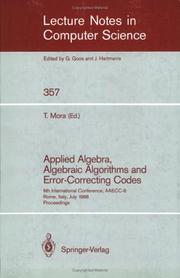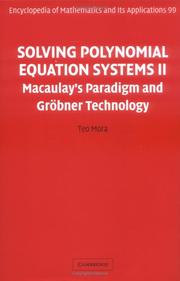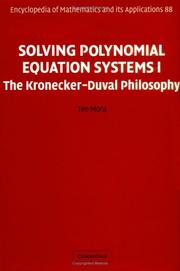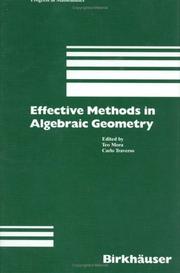| Listing 1 - 10 of 16 | << page >> |
Sort by
|

ISBN: 3540510834 0387510834 3540461523 Year: 1989 Volume: vol 357 Publisher: Berlin : Springer-Verlag,
Abstract | Keywords | Export | Availability | Bookmark
 Loading...
Loading...Choose an application
- Reference Manager
- EndNote
- RefWorks (Direct export to RefWorks)
In 1988, for the first time, the two international conferences AAECC-6 and ISSAC'88 (International Symposium on Symbolic and Algebraic Computation, see Lecture Notes in Computer Science 358) have taken place as a Joint Conference in Rome, July 4-8, 1988. The topics of the two conferences are in fact widely related to each other and the Joint Conference presented a good occasion for the two research communities to meet and share scientific experiences and results. The proceedings of the AAECC-6 are included in this volume. The main topics are: Applied Algebra, Theory and Application of Error-Correcting Codes, Cryptography, Complexity, Algebra Based Methods and Applications in Symbolic Computing and Computer Algebra, and Algebraic Methods and Applications for Advanced Information Processing. Twelve invited papers on subjects of common interest for the two conferences are divided between this volume and the succeeding Lecture Notes volume devoted to ISSACC'88. The proceedings of the 5th conference are published as Vol. 356 of the Lecture Notes in Computer Science.
Computer science --- Information systems --- 681.3*E3 --- 681.3*E4 --- 681.3*F2 --- 681.3*G2 --- 681.3*I1 --- Data encryption: data encryption standard; DES; public key cryptosystems --- Coding and information theory: data compaction and compression; formal modelsof communication; nonsecret encoding schemes--See also {681.3*H11} --- Analysis of algorithms and problem complexity--See also {681.3*B6}; {681.3*B7}; {681.3*F13} --- Discrete mathematics (Mathematics of computing) --- Algebraic manipulation (Computing methodologies) --- 681.3*I1 Algebraic manipulation (Computing methodologies) --- 681.3*G2 Discrete mathematics (Mathematics of computing) --- 681.3*F2 Analysis of algorithms and problem complexity--See also {681.3*B6}; {681.3*B7}; {681.3*F13} --- 681.3*E4 Coding and information theory: data compaction and compression; formal modelsof communication; nonsecret encoding schemes--See also {681.3*H11} --- 681.3*E3 Data encryption: data encryption standard; DES; public key cryptosystems --- Programming languages (Electronic computers) --- Congresses --- Error-correcting codes (Information theory) --- Algebra --- Computer algorithms --- Congresses. --- Data processing --- Algebra. --- Mathematics. --- Coding theory. --- Applications of Mathematics. --- Coding and Information Theory. --- Symbolic and Algebraic Manipulation. --- Data processing. --- Data compression (Telecommunication) --- Digital electronics --- Information theory --- Machine theory --- Signal theory (Telecommunication) --- Computer programming --- Math --- Science --- Mathematics --- Mathematical analysis

ISBN: 0521811562 9780521811569 Year: 2005 Volume: 99 Publisher: Cambridge Cambridge University press
Abstract | Keywords | Export | Availability | Bookmark
 Loading...
Loading...Choose an application
- Reference Manager
- EndNote
- RefWorks (Direct export to RefWorks)
Equations --- Iterative methods (Mathematics) --- numerical solutions --- 512.62 --- -Iterative methods (Mathematics) --- Polynomials --- Algebra --- Mathematics --- Iteration (Mathematics) --- Numerical analysis --- Fields. Polynomials --- Numerical solutions --- 512.62 Fields. Polynomials --- Equations - numerical solutions

ISBN: 9781107340954 9780521811569 1107340950 9781107266902 1107266904 9781299707610 1299707610 9781107269989 1107269989 9780521811545 0521811546 0521811562 9780521811552 0521811554 1139883003 1107266556 110726443X 1107263344 1107267978 9781139015998 Year: 2005 Volume: v. 99 Publisher: Cambridge Cambridge University Press
Abstract | Keywords | Export | Availability | Bookmark
 Loading...
Loading...Choose an application
- Reference Manager
- EndNote
- RefWorks (Direct export to RefWorks)
The second volume of this comprehensive treatise focusses on Buchberger theory and its application to the algorithmic view of commutative algebra. In distinction to other works, the presentation here is based on the intrinsic linear algebra structure of Groebner bases, and thus elementary considerations lead easily to the state-of-the-art in issues of implementation. The same language describes the applications of Groebner technology to the central problems of commutative algebra. The book can be also used as a reference on elementary ideal theory and a source for the state-of-the-art in its algorithmization. Aiming to provide a complete survey on Groebner bases and their applications, the author also includes advanced aspects of Buchberger theory, such as the complexity of the algorithm, Galligo's theorem, the optimality of degrevlex, the Gianni-Kalkbrener theorem, the FGLM algorithm, and so on. Thus it will be essential for all workers in commutative algebra, computational algebra and algebraic geometry.
Equations --- Polynomials. --- Iterative methods (Mathematics) --- Iteration (Mathematics) --- Numerical analysis --- Algebra --- Numerical solutions. --- Graphic methods --- Gröbner bases. --- Gröbner basis theory --- Commutative algebra

ISBN: 9780511542831 9780521811545 0511064497 9780511064494 0511542836 0511072953 9780511072956 1280418559 9786610418558 0511178883 1139147919 0511058160 0511306024 0521811546 Year: 2003 Publisher: Cambridge Cambridge University Press
Abstract | Keywords | Export | Availability | Bookmark
 Loading...
Loading...Choose an application
- Reference Manager
- EndNote
- RefWorks (Direct export to RefWorks)
Polynomial equations have been long studied, both theoretically and with a view to solving them. Until recently, manual computation was the only solution method and the theory was developed to accommodate it. With the advent of computers, the situation changed dramatically. Many classical results can be more usefully recast within a different framework which in turn lends itself to further theoretical development tuned to computation. This first book in a trilogy is devoted to the new approach. It is a handbook covering the classical theory of finding roots of a univariate polynomial, emphasising computational aspects, especially the representation and manipulation of algebraic numbers, enlarged by more recent representations like the Duval Model and the Thom Codification. Mora aims to show that solving a polynomial equation really means finding algorithms that help one manipulate roots rather than simply computing them; to that end he also surveys algorithms for factorizing univariate polynomials.
Equations --- Polynomials. --- Iterative methods (Mathematics) --- Iteration (Mathematics) --- Numerical analysis --- Algebra --- Numerical solutions. --- Graphic methods --- Polynomials --- Equations - numerical solutions --- 512.62 --- -Iterative methods (Mathematics) --- Mathematics --- 512.62 Fields. Polynomials --- Fields. Polynomials --- Numerical solutions
Book
ISBN: 1316383180 1316359182 1316360385 1316359786 1316384985 1316271900 1316379582 Year: 2016 Publisher: Cambridge : Cambridge University Press,
Abstract | Keywords | Export | Availability | Bookmark
 Loading...
Loading...Choose an application
- Reference Manager
- EndNote
- RefWorks (Direct export to RefWorks)
In this fourth and final volume the author extends Buchberger's Algorithm in three different directions. First, he extends the theory to group rings and other Ore-like extensions, and provides an operative scheme that allows one to set a Buchberger theory over any effective associative ring. Second, he covers similar extensions as tools for discussing parametric polynomial systems, the notion of SAGBI-bases, Gröbner bases over invariant rings and Hironaka's theory. Finally, Mora shows how Hilbert's followers - notably Janet, Gunther and Macaulay - anticipated Buchberger's ideas and discusses the most promising recent alternatives by Gerdt (involutive bases) and Faugère (F4 and F5). This comprehensive treatment in four volumes is a significant contribution to algorithmic commutative algebra that will be essential reading for algebraists and algebraic geometers.
Equations --- Polynomials. --- Iterative methods (Mathematics) --- Numerical solutions. --- Iteration (Mathematics) --- Numerical analysis --- Algebra --- Graphic methods
Book
ISBN: 9781107109636 1107109639 9781316271902 Year: 2016 Publisher: Cambridge Cambridge University Press
Abstract | Keywords | Export | Availability | Bookmark
 Loading...
Loading...Choose an application
- Reference Manager
- EndNote
- RefWorks (Direct export to RefWorks)
Book
Year: 2003 Publisher: Cambridge Cambridge University Press
Abstract | Keywords | Export | Availability | Bookmark
 Loading...
Loading...Choose an application
- Reference Manager
- EndNote
- RefWorks (Direct export to RefWorks)
Book
ISBN: 1316287327 1316308138 1316321517 1316331539 1316324850 131631815X 1139015990 Year: 2015 Publisher: Cambridge : Cambridge University Press,
Abstract | Keywords | Export | Availability | Bookmark
 Loading...
Loading...Choose an application
- Reference Manager
- EndNote
- RefWorks (Direct export to RefWorks)
This third volume of four finishes the program begun in Volume 1 by describing all the most important techniques, mainly based on Gröbner bases, which allow one to manipulate the roots of the equation rather than just compute them. The book begins with the 'standard' solutions (Gianni-Kalkbrener Theorem, Stetter Algorithm, Cardinal-Mourrain result) and then moves on to more innovative methods (Lazard triangular sets, Rouillier's Rational Univariate Representation, the TERA Kronecker package). The author also looks at classical results, such as Macaulay's Matrix, and provides a historical survey of elimination, from Bézout to Cayley. This comprehensive treatment in four volumes is a significant contribution to algorithmic commutative algebra that will be essential reading for algebraists and algebraic geometers.
Equations --- Polynomials. --- Iterative methods (Mathematics) --- Numerical solutions.

Abstract | Keywords | Export | Availability | Bookmark
 Loading...
Loading...Choose an application
- Reference Manager
- EndNote
- RefWorks (Direct export to RefWorks)
Book
Abstract | Keywords | Export | Availability | Bookmark
 Loading...
Loading...Choose an application
- Reference Manager
- EndNote
- RefWorks (Direct export to RefWorks)
| Listing 1 - 10 of 16 | << page >> |
Sort by
|

 Search
Search Feedback
Feedback About UniCat
About UniCat  Help
Help News
News